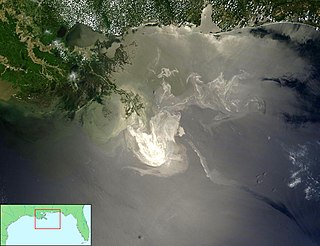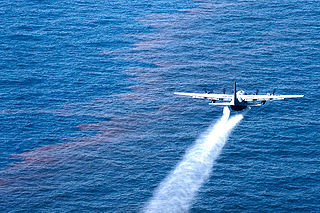
Deepwater Horizon was an ultra-deepwater, dynamically positioned, semi-submersible offshore drilling rig owned by Transocean and operated by BP. On 20 April 2010, while drilling at the Macondo Prospect, a blowout caused an explosion on the rig that killed 11 crewmen and ignited a fireball visible from 40 miles (64 km) away. The fire was inextinguishable and, two days later, on 22 April, the Horizon sank, leaving the well gushing at the seabed and causing the largest marine oil spill in history.
A dispersant or a dispersing agent is a substance, typically a surfactant, that is added to a suspension of solid or liquid particles in a liquid to improve the separation of the particles and to prevent their settling or clumping.

The Deepwater Horizon oil spill was an industrial disaster that began on 20 April 2010 off of the coast of the United States in the Gulf of Mexico on the BP-operated Macondo Prospect, considered to be the largest marine oil spill in the history of the petroleum industry and estimated to be 8 to 31 percent larger in volume than the previous largest, the Ixtoc I oil spill, also in the Gulf of Mexico. The United States federal government estimated the total discharge at 4.9 MMbbl. After several failed efforts to contain the flow, the well was declared sealed on 19 September 2010. Reports in early 2012 indicated that the well site was still leaking. The Deepwater Horizon oil spill is regarded as one of the largest environmental disasters in world history.
The Macondo Prospect is an oil and gas prospect in the United States Exclusive Economic Zone of the Gulf of Mexico, off the coast of Louisiana. The prospect was the site of the Deepwater Horizon drilling rig explosion in April 2010 that led to a major oil spill in the region from the first exploration well, named itself MC252-1, which had been designed to investigate the existence of the prospect.

The Deepwater Horizon drilling rig explosion was an April 20, 2010 explosion and subsequent fire on the Deepwater Horizon semi-submersible mobile offshore drilling unit, which was owned and operated by Transocean and drilling for BP in the Macondo Prospect oil field about 40 miles (64 km) southeast off the Louisiana coast. The explosion and subsequent fire resulted in the sinking of the Deepwater Horizon and the deaths of 11 workers; 17 others were injured. The same blowout that caused the explosion also caused an oil well fire and a massive offshore oil spill in the Gulf of Mexico, considered the largest accidental marine oil spill in the world, and the largest environmental disaster in United States history.

Corexit is a product line of oil dispersants used during oil spill response operations. It is produced by Nalco Holding Company, an indirect subsidiary of Ecolab. Corexit was originally developed by the Standard Oil Company of New Jersey. Corexit is typically applied by aerial spraying or spraying from ships directly onto an oil slick. On contact with the dispersant, oil that would otherwise float on the surface of the water is emulsified into tiny droplets and sinks or remains suspended in the water. In theory this allows the oil to be more rapidly degraded by bacteria (bioremediation) and prevents it from accumulating on beaches and in marshes.
The National Commission on the BP Deepwater Horizon Oil Spill and Offshore Drilling is a bipartisan presidential commission, established by Executive Order 13543 signed by Barack Obama on May 21, 2010, that is "tasked with providing recommendations on how the United States can prevent and mitigate the impact of any future spills that result from offshore drilling." It came about as a result of the April 2010 Deepwater Horizon oil spill. The first public hearings, held on July 12 and 13, 2010 in New Orleans, included scheduled testimony from Federal government officials and representatives of BP on the status of the spill and clean-up efforts, as well as from local officials, community leaders, and scientists on the economic, cultural and ecological impacts of the oil spill on Gulf Coast communities and ecosystems.
The following is a timeline of the Deepwater Horizon oil spill. It was a massive oil spill in the Gulf of Mexico, the largest offshore spill in U.S. history. It was a result of the well blowout that began with the Deepwater Horizon drilling rig explosion on April 20, 2010.
This article covers the effect of the Deepwater Horizon disaster and the resulting oil spill on global and national economies and the energy industry.
Following is a timeline of the Deepwater Horizon oil spill for June 2010.
Following is a timeline of the Deepwater Horizon oil spill for July 2010.
Following is a Timeline of the Deepwater Horizon oil spill for May 2010.
Reactions to the Deepwater Horizon oil spill from various officials and interested parties ranged from blame and outrage at the damage caused by the spill, to calls for greater accountability on the part of the U.S. government and BP, including new legislation dealing with preventative security and clean-up improvements.
Efforts to stem the Deepwater Horizon oil spill were ongoing from the time that the Deepwater Horizon exploded on April 20, 2010 until the well was sealed by a cap on July 15, 2010. Various species of dolphins and other mammals, birds, and the endangered sea turtles have been killed either directly or indirectly by the oil spill. The Deepwater Horizon spill has surpassed in volume the 1989 Exxon Valdez oil spill as the largest ever to originate in U.S.-controlled waters; it is comparable to the 1979 Ixtoc I oil spill in total volume released.
The Deepwater Horizon investigation included several investigations and commissions, among others reports by National Incident Commander Thad Allen, United States Coast Guard, National Commission on the BP Deepwater Horizon Oil Spill and Offshore Drilling, Bureau of Ocean Energy Management, Regulation and Enforcement, National Academy of Engineering, National Research Council, Government Accountability Office, National Oil Spill Commission, and Chemical Safety and Hazard Investigation Board.
The Deepwater Horizon Oil Spill Trust is the $20 billion trust fund established by BP to settle claims arising from the Deepwater Horizon oil spill. The fund was established to be used for natural resource damages, state and local response costs and individual compensation. It was established as Gulf Coast Claims Facility (GCCF), announced on 16 June 2010 after a meeting of BP executives with U.S. President Barack Obama. In June 2012, the settlement of claims through the GCCF was replaced by the court supervised settlement program.
The Health consequences of the Deepwater Horizon oil spill are health effects related to the explosion of the Deepwater Horizon offshore drilling rig in the Gulf of Mexico on April 20, 2010. An oil discharge continued for 84 days, resulting in the largest oil spill in the history of the petroleum industry, estimated at approximately 206 million gallons. The spill exposed thousands of area residents and cleanup workers to risks associated with oil fumes, particulate matter from Controlled burns, volatile organic compounds (VOCs), polycylic aromatic hydrocarbons (PAHs), and heavy metals.

The Deepwater Horizon oil spill occurred between 10 April and 19 September 2010 in the Gulf of Mexico. A variety of techniques were used to address fundamental strategies for addressing the spilled oil, which were: to contain oil on the surface, dispersal, and removal. While most of the oil drilled off Louisiana is a lighter crude, the leaking oil was of a heavier blend which contained asphalt-like substances. According to Ed Overton, who heads a federal chemical hazard assessment team for oil spills, this type of oil emulsifies well. Once it becomes emulsified, it no longer evaporates as quickly as regular oil, does not rinse off as easily, cannot be broken down by microbes as easily, and does not burn as well. "That type of mixture essentially removes all the best oil clean-up weapons", Overton said.

The GuLF Study, or Gulf Long-term Follow-up Study, is a five-year research project examining the human-health consequences of the Deepwater Horizon oil spill in April 2010. The spill followed an explosion on a drilling rig leased by BP, the British oil company, and led to the release of over four million barrels of oil into the Gulf of Mexico, 48 miles off the coast of Louisiana in the United States.

The RESTORE Act is a United States federal statute that was signed into law by President Barack Obama on July 6, 2012. It was enacted by the 112th United States Congress as an amendment of the Moving Ahead for Progress in the 21st Century Act (MAP-21), a transportation bill that included many other provisions. The act was in response to the Deepwater Horizon oil spill that occurred on April 20, 2010, which caused significant environmental, ecological, and economic damage to the U.S. Gulf Coast.







